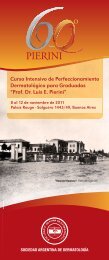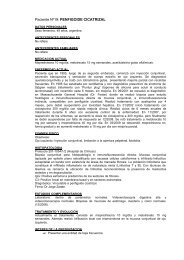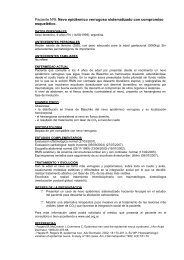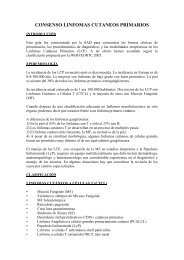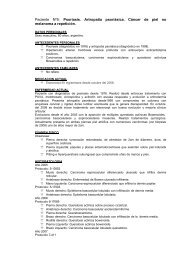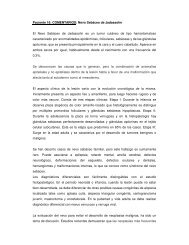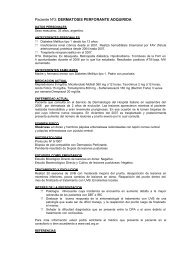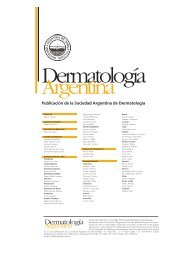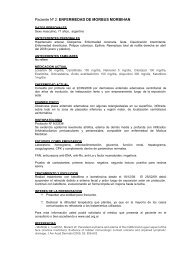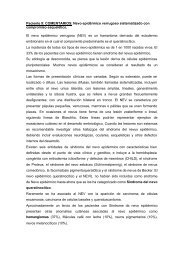Publicación de la Sociedad Argentina de Derm atolog à a
Publicación de la Sociedad Argentina de Derm atolog à a
Publicación de la Sociedad Argentina de Derm atolog à a
You also want an ePaper? Increase the reach of your titles
YUMPU automatically turns print PDFs into web optimized ePapers that Google loves.
Volumen VIII - Nº 5 - 2002<br />
D e rm<strong>atolog</strong>ía<br />
A rg e n t i n a<br />
Nevo <strong>de</strong> Sutton:<br />
p resentación <strong>de</strong> 47<br />
pacientes vistos en<br />
una Sección <strong>de</strong><br />
D e rm<strong>atolog</strong>ía Pediátrica<br />
Santos Muñoz A,* Carbajosa A,* Giachetti A,* Larral<strong>de</strong> M**<br />
*Médicas <strong>de</strong> <strong>la</strong> Sección <strong>Derm</strong><strong>atolog</strong>ía<br />
Pediátrica, Hospital "J. M. Ramos<br />
Mejía", Bs. As.<br />
** Jefa <strong>de</strong> Sección <strong>Derm</strong><strong>atolog</strong>ía<br />
Pediátrica, Hospital "J. M. Ramos<br />
Mejía", Bs. As.<br />
Fecha <strong>de</strong> recepción: 23/08/01<br />
Fecha <strong>de</strong> aprobación: 8/2/02<br />
"La regresión parcial o completa <strong>de</strong> tumores malignos o benignos es interesante, porque pone en evi<strong>de</strong>ncia<br />
que si, en raras ocasiones, el organismo humano logra <strong>de</strong>shacerse espontáneamente <strong>de</strong> un tumor, algún día<br />
el intelecto humano podrá compren<strong>de</strong>r a fondo el mecanismo <strong>de</strong> ese proceso."<br />
Roh<strong>de</strong>mberg Arch Path Lab Med 1927; 3: 195.<br />
Resumen<br />
Se <strong>de</strong>nomina nevo <strong>de</strong> Sutton a <strong>la</strong> aparición <strong>de</strong> un halo<br />
<strong>de</strong> hipome<strong>la</strong>nosis alre<strong>de</strong>dor <strong>de</strong> un tumor cutáneo<br />
central, el cual es habitualmente un nevo me<strong>la</strong>nocítico.<br />
Informamos los casos <strong>de</strong> pacientes con nevo <strong>de</strong> Sutton<br />
vistos entre febrero <strong>de</strong> 1998 y mayo <strong>de</strong> 2000. Se examinaron<br />
47 pacientes, 23 mujeres y 24 varones, con<br />
nevos me<strong>la</strong>nocíticos; sus eda<strong>de</strong>s iban <strong>de</strong> 5 a 17 años.<br />
Del total, 12 tenían 5 a 8 años; 17, 9 a 12 años, y 18<br />
eran mayores <strong>de</strong> 12 años.<br />
Los nevos <strong>de</strong> Sutton observados fueron, como lesión<br />
única, en 22 pacientes; 2 a 5 lesiones, en 19 pacientes,<br />
y más <strong>de</strong> 5 lesiones, en 6 pacientes.<br />
Del total, 47 se localizaron en el tronco, 10 en <strong>la</strong> cabeza<br />
y 7 en los miembros. Efectuamos estudio histopatológico<br />
en sólo 11 pacientes. En re<strong>la</strong>ción con los antece<strong>de</strong>ntes<br />
personales, hal<strong>la</strong>mos que 26 pacientes tenían<br />
hasta 10 nevos, 14 tenían más <strong>de</strong> 10 y sólo 7 no<br />
tenían otros nevos; en 5 pacientes había nevos atípicos<br />
(2 <strong>de</strong> ellos con síndrome <strong>de</strong> nevos atípicos familiares)<br />
y sólo 8 pacientes presentaban vitíligo en el momento<br />
<strong>de</strong> <strong>la</strong> consulta.<br />
Los antece<strong>de</strong>ntes familiares fueron los siguientes: familiares<br />
directos con nevos múltiples, 19; con nevos<br />
atípicos, 11; con me<strong>la</strong>noma, 5, y con vitíligo, 6.<br />
Presentamos este trabajo porque creemos que 47 pacientes<br />
constituyen una casuística importante <strong>de</strong> nevo<br />
<strong>de</strong> Sutton, <strong>de</strong> <strong>la</strong> cual pudimos sacar conclusiones relevantes<br />
(<strong>Derm</strong>atol Argent 2002; Nº 5: 270-273)<br />
Pa<strong>la</strong>bras c<strong>la</strong>ves: nevo halo, nevo <strong>de</strong> Sutton, halo nevo.<br />
Summary<br />
Halo nevi, Sutton nevi or leuko<strong>de</strong>rma acquisitum centrifugum<br />
are terms that refer to the onset of a hypome<strong>la</strong>notic<br />
halo surrounding a central cutaneous tumour; this<br />
<strong>la</strong>st one usually consisting of a me<strong>la</strong>nocitic nevi, blue nevi,<br />
neuro f i b roma or me<strong>la</strong>noma.<br />
We re p o rt 47 patients presenting Sutton nevus that were<br />
seen in our <strong>de</strong>partment, between febru a ry of 1998<br />
and may of 2000.<br />
F rom this total, 23 were females and 24 were males, in<br />
all of the cases the central lesion was a me<strong>la</strong>nocitic nevi.<br />
The age of consultation was 5 to 17 years old;distributed<br />
as follows : 12 patients aged 5 to 8, 17 patients aged 9 to<br />
12 , and 18 patients ol<strong>de</strong>r than 12 years of age.<br />
The patients presented a single halo nevi in 22 cases, 2-5<br />
lesions in 19 cases, and more than 5 lesions in 6 cases<br />
(one patient had 18 lesions).<br />
R e g a rding to the localization of the lesions, most of the<br />
them (41 lesions) appeared in the trunk, 10 lesions in the<br />
head and 7 lesions in the limbs. A biopsy was ma<strong>de</strong> in<br />
only 11 patients.<br />
In the patients personal history we found another nevus<br />
in 40 of them, 26 of which presented up to 10 lesions and<br />
14 more than 10 lesions, only 7 patients had had no other<br />
nevus; 5 of the patients presented atipic nevus (2<br />
with atipic nevus syndrome), we observed vitíligo lesions<br />
in only 8 patients at the time of the consultation.<br />
With respect to family history, 19 patients had direct re<strong>la</strong>tives<br />
with multiple nevus, 11 patients with atipic nevus<br />
, 5 patients with me<strong>la</strong>noma and 6 patients with vitíligo.<br />
We re p o rt this conclusions as we believe that 47 patients<br />
does constitute an important casuistic about the Sutton<br />
nevus that lead us to relevant inform a t i o n .<br />
Key words: halo nevus, vitíligo, Sutton nevus.<br />
270



